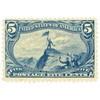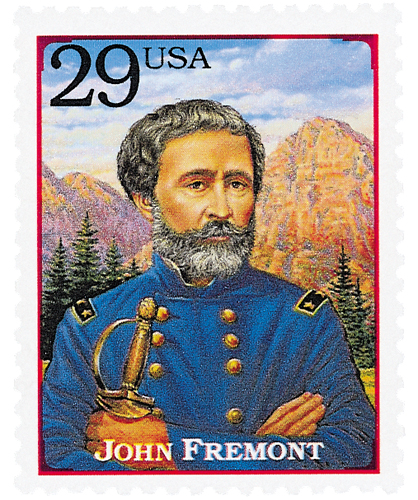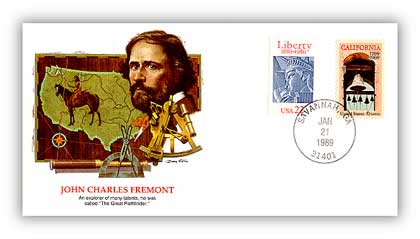
# 288 - 1898 5c Trans-Mississippi Exposition: Fremont in Rockies
1898 5¢ Trans-Mississippi Exposition
First Day of Issue: June 17, 1898
Quantity issued: 7,694,180 (unknown quantity later destroyed)
Printed by: Bureau of Engraving and Printing
Method: Flat Plate in sheets of 100 subjects
Watermark: Double-line watermark USPS
Perforation: 12
Color: Dull blue
Death Of John C. Frémont
Frémont was born on January 21, 1813 in Savannah, Georgia. As a child, he was described as “precious, handsome, and daring.” After his father died, when he was just five years old, a family friend helped to pay for his education. Frémont attended Charleston College, but didn’t graduate despite his talent for math and natural sciences.

After leaving school in 1831, Frémont took a job teaching math aboard the USS Natchez. He was then made a second lieutenant in the United States Topographical Corps. Between 1838 and 1839, he joined Joseph Nicollet on expeditions to the land between the Mississippi and Missouri Rivers.
Frémont married Jessie Benton, daughter of Senator Thomas Hart Benton, in 1841. Benton championed the expansionist movement known as Manifest Destiny. Benton and Frémont believed the entire North American continent should belong to the citizens of the US – that it was the nation’s destiny. Benton arranged for Congressional appropriations to fund expeditions to the Oregon Trail, the Great Basin, the Sierra Nevada Mountains and California. Using his influence, Benton also arranged for Frémont to lead each expedition.

During these four expeditions, Frémont became known as “The Pathfinder,” exploring the vast territory west of the Mississippi River to the Pacific Ocean. While on his first expedition to Wyoming in 1842, he met frontiersman Christopher “Kit” Carson, who later became his trusted companion and guide.
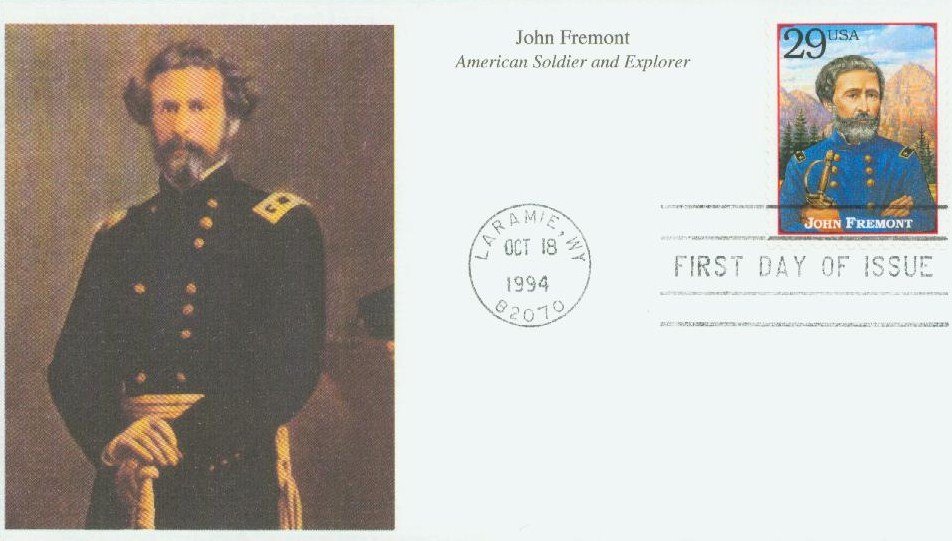
Frémont’s “Report of the Exploring Expedition to the Rocky Mountains” described his adventures and established his reputation as a seasoned explorer. These early travels helped him develop the first scientific map of the American West. Pioneers who dared to head west later traveled on his recorded trails, and were guided by his excellent descriptions.
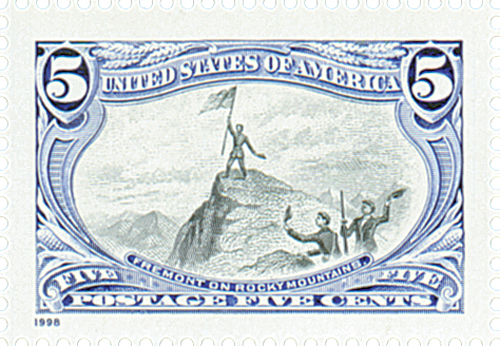
War with Mexico was eminent when Frémont organized his second expedition to California in 1845. Aiding Commodore Robert Stockton and General Stephen Kearny in the conquest of California, he played an important role in the development of our 31st state. Settling there briefly, he gained significant wealth from the Gold Rush and served as one of the state’s first two senators.
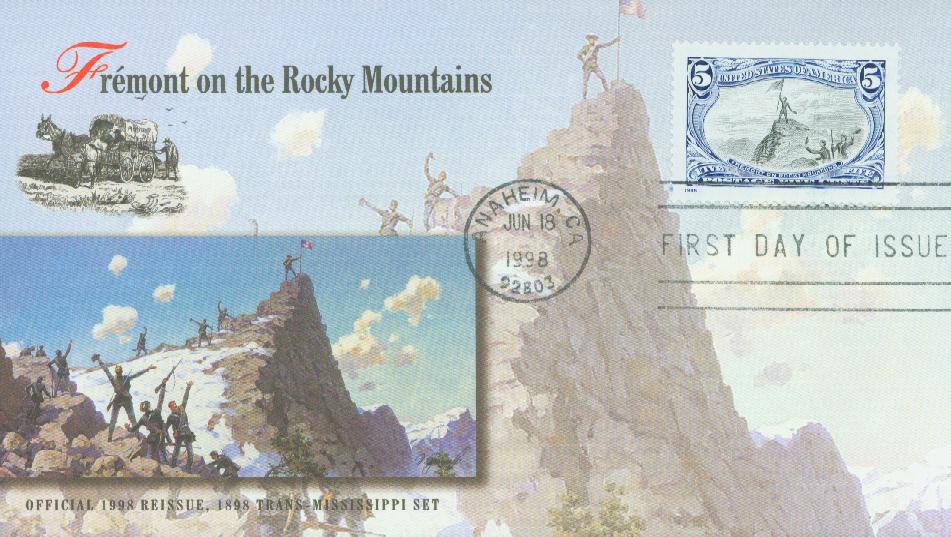
In June 1856, Frémont became the first presidential candidate of the newly formed Republican Party. Although he had also been asked to be the Democratic presidential candidate, he refused because the party supported slavery. Fearing that his election would cause the Southern states to secede and possibly lead to a civil war, the Democrats strongly opposed his nomination. Although he carried eleven states, Buchanan, his Democratic rival, carried 19, and Frémont lost the election.
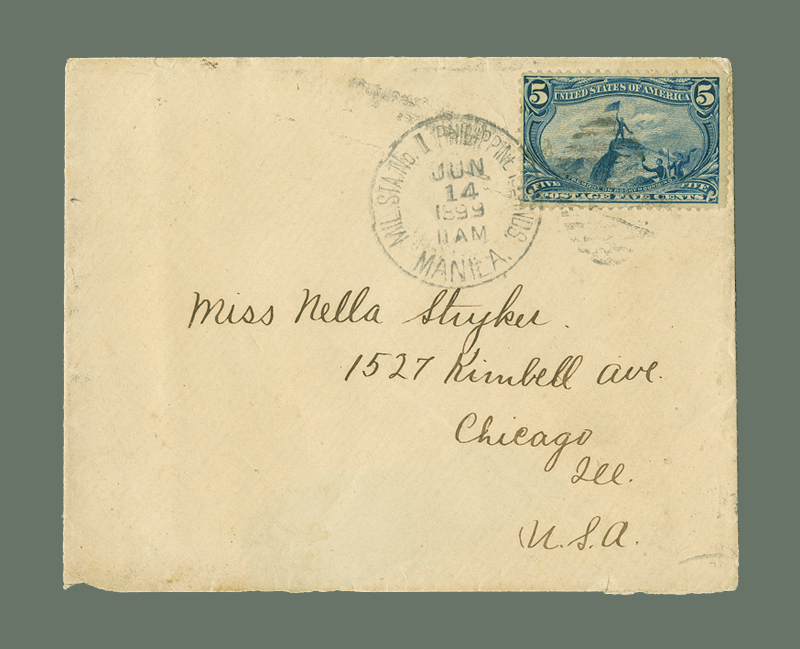
Frémont also served during the Civil War. He was the commander of the Department of the West for five months before being dismissed by President Lincoln. Following the Civil War, Frémont retired from public life to devote himself to finding a possible transcontinental railroad route. In 1878, he was appointed territorial governor of Arizona, a position he held until 1881. In early July 1890, Frémont suffered from a brief illness brought on by a hot summer day. He died days later on July 13, 1890.
1898 5¢ Trans-Mississippi Exposition
First Day of Issue: June 17, 1898
Quantity issued: 7,694,180 (unknown quantity later destroyed)
Printed by: Bureau of Engraving and Printing
Method: Flat Plate in sheets of 100 subjects
Watermark: Double-line watermark USPS
Perforation: 12
Color: Dull blue
Death Of John C. Frémont
Frémont was born on January 21, 1813 in Savannah, Georgia. As a child, he was described as “precious, handsome, and daring.” After his father died, when he was just five years old, a family friend helped to pay for his education. Frémont attended Charleston College, but didn’t graduate despite his talent for math and natural sciences.

After leaving school in 1831, Frémont took a job teaching math aboard the USS Natchez. He was then made a second lieutenant in the United States Topographical Corps. Between 1838 and 1839, he joined Joseph Nicollet on expeditions to the land between the Mississippi and Missouri Rivers.
Frémont married Jessie Benton, daughter of Senator Thomas Hart Benton, in 1841. Benton championed the expansionist movement known as Manifest Destiny. Benton and Frémont believed the entire North American continent should belong to the citizens of the US – that it was the nation’s destiny. Benton arranged for Congressional appropriations to fund expeditions to the Oregon Trail, the Great Basin, the Sierra Nevada Mountains and California. Using his influence, Benton also arranged for Frémont to lead each expedition.

During these four expeditions, Frémont became known as “The Pathfinder,” exploring the vast territory west of the Mississippi River to the Pacific Ocean. While on his first expedition to Wyoming in 1842, he met frontiersman Christopher “Kit” Carson, who later became his trusted companion and guide.

Frémont’s “Report of the Exploring Expedition to the Rocky Mountains” described his adventures and established his reputation as a seasoned explorer. These early travels helped him develop the first scientific map of the American West. Pioneers who dared to head west later traveled on his recorded trails, and were guided by his excellent descriptions.

War with Mexico was eminent when Frémont organized his second expedition to California in 1845. Aiding Commodore Robert Stockton and General Stephen Kearny in the conquest of California, he played an important role in the development of our 31st state. Settling there briefly, he gained significant wealth from the Gold Rush and served as one of the state’s first two senators.

In June 1856, Frémont became the first presidential candidate of the newly formed Republican Party. Although he had also been asked to be the Democratic presidential candidate, he refused because the party supported slavery. Fearing that his election would cause the Southern states to secede and possibly lead to a civil war, the Democrats strongly opposed his nomination. Although he carried eleven states, Buchanan, his Democratic rival, carried 19, and Frémont lost the election.

Frémont also served during the Civil War. He was the commander of the Department of the West for five months before being dismissed by President Lincoln. Following the Civil War, Frémont retired from public life to devote himself to finding a possible transcontinental railroad route. In 1878, he was appointed territorial governor of Arizona, a position he held until 1881. In early July 1890, Frémont suffered from a brief illness brought on by a hot summer day. He died days later on July 13, 1890.










